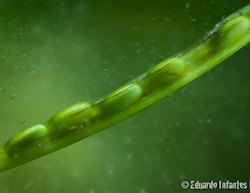Abstract
Seagrasses are foundation species in coastal ecosystems promoting biodiversity and community structure. Future marine carbonate chemistry under ocean acidification may enhance seagrass physiology, but little is known about how reproductive ecology and disease will integrate into future ocean conditions.
A novel pathogen, Phytophthora gemini, infects >90 % of eelgrass, Zostera marina, surveyed in Northern Atlantic and Mediterranean populations reducing annual germination 6-fold. Our study investigated the combined effects of ocean acidification and P. gemini infection on germination of eelgrass seeds.
We conducted a two-level factorial experiment crossing four pH levels (∆0, -∆0.3, -∆0.6, -∆0.9; relative to the average pH at the sampling site) with three infection levels (infected, non-infected, exposed) to determine germination rate and infection response. Prior to experimentation, flowering shoots were collected and held in flow-through seawater tanks where seeds ripened naturally. Once collected, seeds were held in copper sulfate solution (27.37 ± 1.57 ppt) and stored in darkness to mimic winter dormancy (4 °C). Before the start of the experiment, viable seeds were cultured on oomycete selective growth media to determine infection status. By the end of the experiment, 100% of tested seeds, regardless of treatment, contained P. gemini.
Germination rate significantly increased with decreased pH. Our findings indicate that P. gemini is not inhibited by ecologically relevant changes to carbonate chemistry and standard handling practices can result in effective and highly virulent disease transmission. These results confirm perennial populations of eelgrass are susceptible to infection and alerts conservationists to additional considerations necessary for successful eelgrass restoration.









